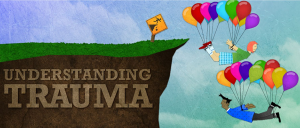A siren wailing somewhere in the night. Flashing police lights and yellow tape. The chaos of an emergency room after a big accident. A loved one being hurt or perpetrating pain.
Even thinking about these scenarios can be unsettling. When they become reality for us or people we care for, they are traumatic. With every additional instance, the impact from a wide range of experiences becomes more dramatic and damaging. Though the physical signs of trauma are often obvious, the emotional and mental wounds are often harder to see and to care for. For professionals who work with a population that is chronically traumatized, they can find themselves in need of care as well.
Like other first responders, Children’s Services caseworkers and managers deal with trauma every day. And not just during their “official” shifts. Difficult interactions and disturbing images have a way of following them home and moving in. Overstaying their welcome.
Learning how to take care of ourselves and each other is the main goal driving our new, trauma-informed programming. Building a safe place where our dedicated staff can be encouraged and empowered helps counter burnout and turnover while building our resilience and improving job satisfaction. Building a strong JFS community enables us to build a stronger community beyond our walls. One child, one family at a time.
Nina Lewis is overseeing a team of experienced and empathetic professionals. Former caseworker Faye Perkins will offer confidential consultation for staff regarding the behavioral health of children and families as well as addressing their own secondary trauma. In their roles as Trauma Coordinators, Donna Lang and Gina Parran are initially focusing on Resilience Alliance Groups to enable caseworkers and managers to view trauma in a new light. Two, six-month rotations of the groups will foster learning and support for managers and caseworkers alike.
“To help people heal from trauma, you work with their resilience factors. If our workers can engage with families and think about how to connect them with community, to build their self-esteem, it begins to build their resilience factors. And our own,” Lang confirmed.
Parran reported that the investment is already seeing a return. “Some of the feedback so far from both managers and staff is how they are starting to recognize and understand how stress is impacting their bodies. Starting to normalize that as opposed to ‘what’s wrong with me’ and more of ‘this is happening to me’. People are starting to talk and have conversations. The whole group is about building our resilience. Not change the work but change your relationship with how your processing the stress in a healthier way. They’re getting excited as they see how these resilience factors, these tools, can really help them heal and be healthier as they do this work.”
The Resilience Alliance Groups are intentionally positive and interactive. Mindful of not wanting to add another task to the already long list of responsibilities, Lang and Parran are eager to create a community of support and strength. They have already created physical spaces where staff can unplug and decompress.
“It’s also about not just using the tools as a caseworker but as a person when they go home. It’s about showing up and being present as a human being and learning how to navigate life – which can be pretty scary at times,” added Parran.